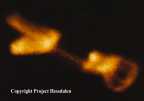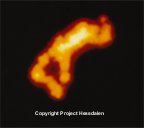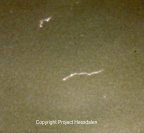|
|
|
|
|
Hessdalen - Pictures of the phenomena
|
Here are some pictures of the phenomena and from the fieldwork.

|
Photo taken by Arne P. Thomassen the 25. October 1982. It is taken with a 400 mm lens in
front, from the mountain Finnsåhøgda south, looking towards east.
|

|
Photo taken by Arne P. Thomassen the 25. October 1982. It is taken with a 400 mm lens in
front, from the mountain Finnsåhøgda south, looking towards east.
|

|
This photo is also taken by Arne P. Thomassen the 25. October 1982. It is taken with a 400 mm lens in
front, from the mountain Finnsåhøgda south, looking towards east.
|

|
This photo is an enlargement of a picture taken by Arne P. Thomassen the 25. October 1982. It is taken with a 400 mm lens in
front, from the mountain Finnsåhøgda south, looking towards east. It shows the form on the light which is called "trailer".
|

|
This photo is taken by Kurt Roger Andersen He was located in Hessdalen, one evening during the winter 1982/1983, looking towards
the mountain Finnsåhøgda. He used a 2000mm lens.
A flashing light was coming above the mountain, which Kurt managed to get in the view
of the camera.
|

|
This photo shows a light that disappear during the exposure time. The light was standing still during the first part of the exposure time.
Suddenly it was gone. The disappearing was captured on to the film.
|

|
These two pictures are taken by Leif Havik 12
February at 17.53. They are taken from Litlfjellet towards
Hessdalen. In the upper picture you can see the northern part
of Aspåskjølen. The light moved towards Litlfjellet, followed
the valley to the left. The lower picture is taken just before
the light disappears behind the mountain in the eastern part
of Litlfjellet. He used a Nikon FG with a 50 mm lens.
|

|

|
Photo taken by Arne P. Thomassen on 25 September between 19.00 and 20.30. It is taken with a 400 mm lens in
front, from the mountain Finnsåhøgda south, looking towards east.
|

|
This is the second photo taken by Arne P. Thomassen on the 25 September between 19.00 and 20.30. It is taken with a 400 mm lens in
front, from the mountain Finnsåhøgda south, looking towards east. It is the same phenomena as the one above.
|

|
Photo taken by Arne P. Thomassen October 1982. It is taken from the mountain
Finnsåhøgda south, looking towards east. Arne used a Minolta XG-2 camera, with
a Vivitar 400mm/5,6 lens.
|

|
Photo showing the third category: Three lights
together. The light at the right is red, and the two others
are yellow-white. Leif Havik shot the picture on 18 March
1982, at 19.33. He used a Practica LTL-3 camera with a 135 mm
lens equipped with a 2x teleconverter.
|

|
Photo showing two moving lights over Finnsåhøgda
(X/4). The picture above is enlarged. The picture below is
grossly enlarged.
|

|

|
Photo taken by Roar Wister (RW1/3) Saturday 21
February at 19.23. Exposure time is 10 seconds. The aperture
is f/5.6. It is taken with a Pentax ME Super with a Vivitar
zoom lens with a range 75-205 mm, adjusted to 75 mm. Just
after the picture was taken, an oscillation could be seen by
the eyes. Probably the same oscillation which you see the
start of in the picture. The frequency is 7 Hz.
|

|

|
Two photos taken by Björn Lagesson on Sunday 26
February at 03.08. They are taken with a grating in front. The
lightstreak you see over the "lightpoint" is the spectrum of
the light. The shortest wavelength is nearest the light. The
picture at left is taken a few seconds before the picture at
right. The report was rated at F5. You may read more about this story in the report: "Spectrographic records".
|

|
The headquarter during Project Hessdalen fieldwork 1985.
|
|
|

